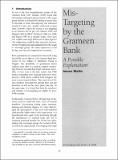| dc.contributor.author | Matin, Imran | en |
| dc.date.accessioned | 2016-02-24T14:52:11Z | |
| dc.date.available | 2016-02-24T14:52:11Z | |
| dc.date.issued | 01/10/1998 | en |
| dc.identifier.citation | Matin, I. (1998) Mis?Targeting by the Grameen Bank: A Possible Explanation. IDS Bulletin 29(4): 51-58 | en |
| dc.identifier.issn | 1759-5436 | en |
| dc.identifier.uri | https://opendocs.ids.ac.uk/opendocs/handle/20.500.12413/9147 | |
| dc.description.abstract | summary There has been an increased emphasis on the targeting efficiency of micro?credit programmes. In general, recent studies find a much higher incidence of mis?targeting (around 25?30 per cent) than previous studies (3?5 per cent). Household survey data from four villages in Madhupur Thana is used to test the hypothesis that rapid progressive lending in the study area since 1992 has affected the selection and participation incentives and worsened both the incidence and severity of mis?targeting. The implication of this finding, if found to hold across other settings, is that loan size and the pace of progressive lending can be used as an indirect targeting instrument. In broader terms, experiments with contract design and service diversification could be useful in covering and benefiting a broader spectrum of the poor. | en |
| dc.format.extent | 8 | en |
| dc.publisher | Institute of Development Studies | en |
| dc.relation.ispartofseries | IDS Bulletin Vol. 29 Nos. 4 | en |
| dc.rights.uri | http://www.ids.ac.uk/files/dmfile/IDSOpenDocsStandardTermsOfUse.pdf | en |
| dc.title | Mis?Targeting by the Grameen Bank: A Possible Explanation | en |
| dc.type | Article | en |
| dc.rights.holder | © 1998 Institue of Development Studies | en |
| dc.identifier.doi | 10.1111/j.1759-5436.1998.mp29004006.x | en |

